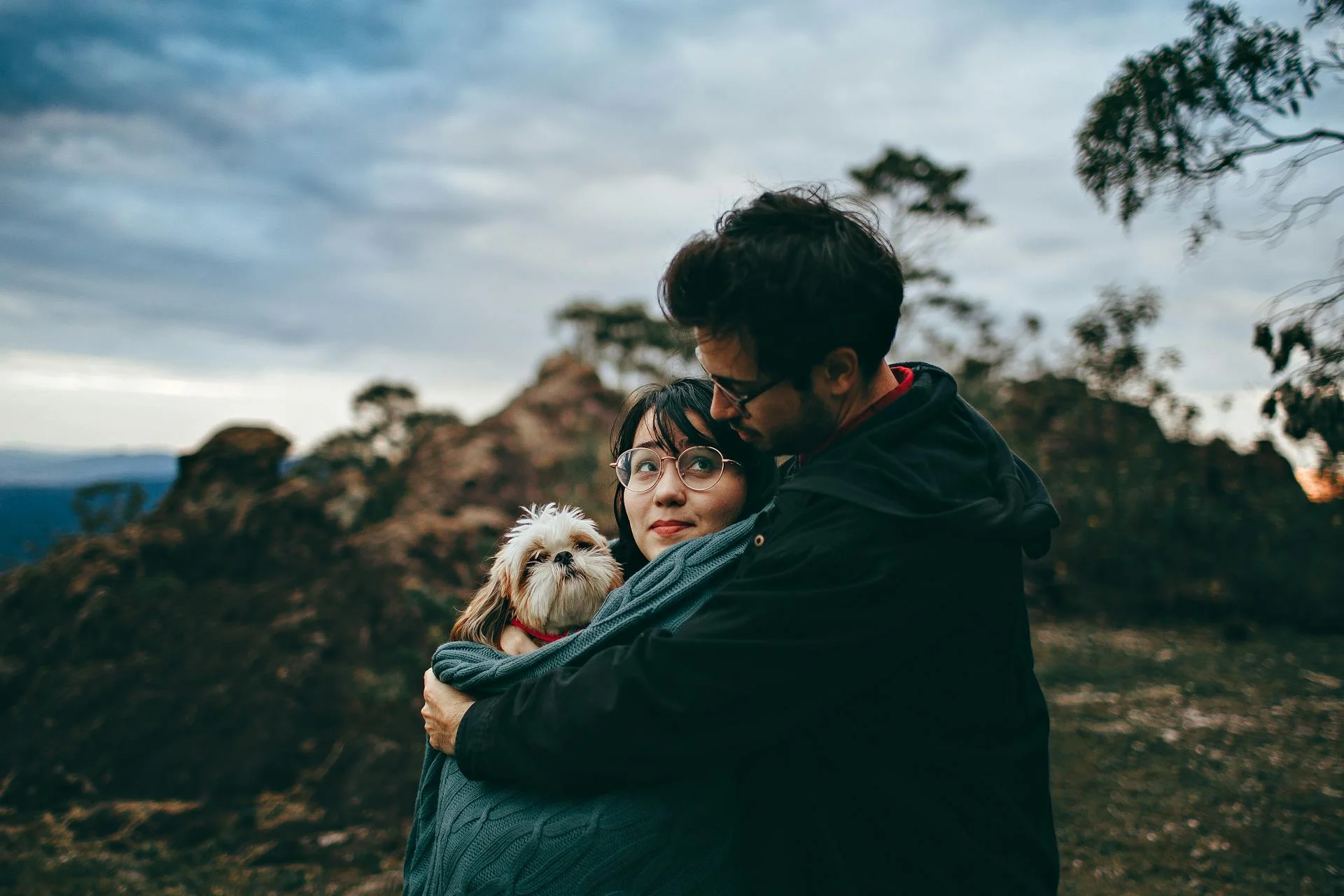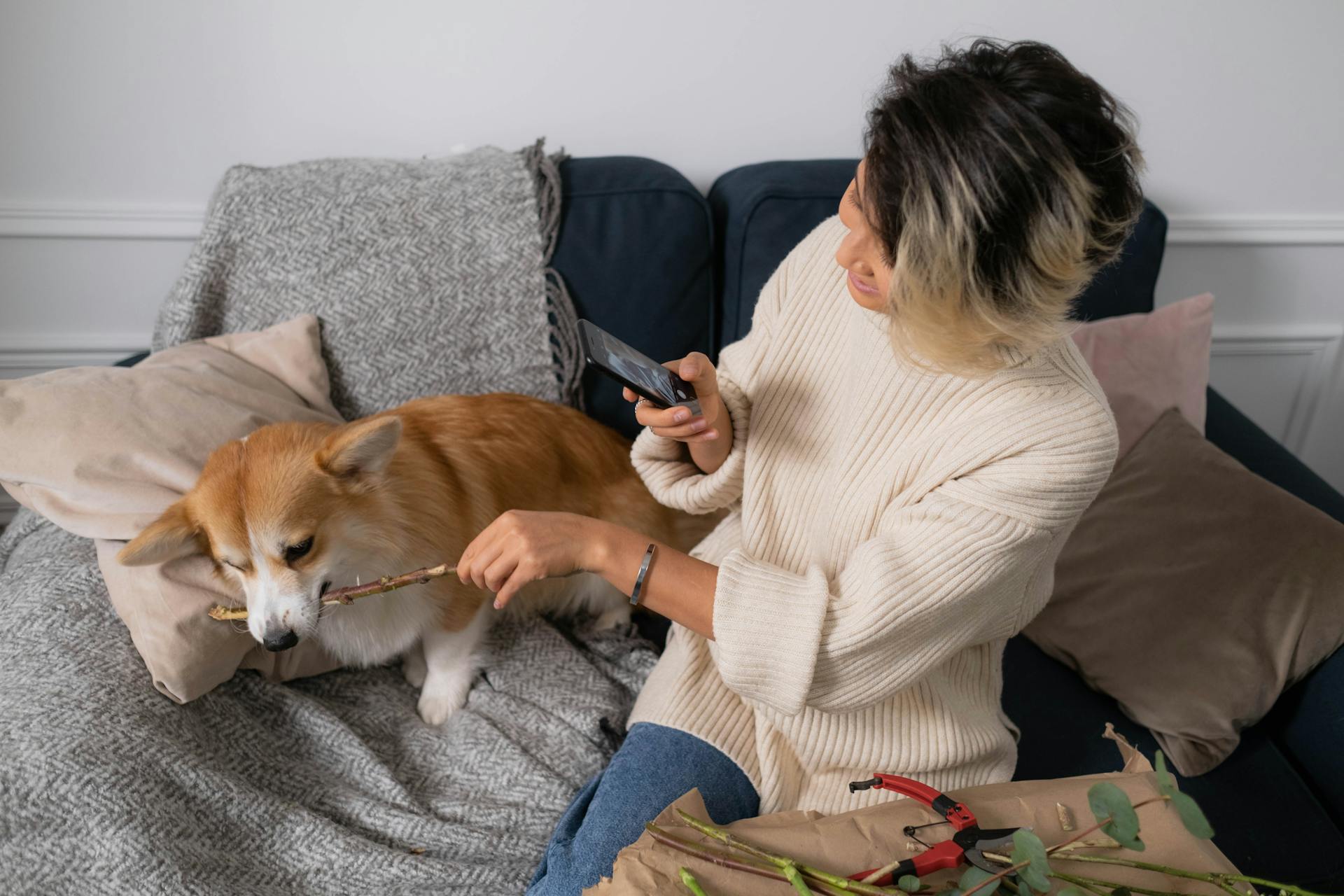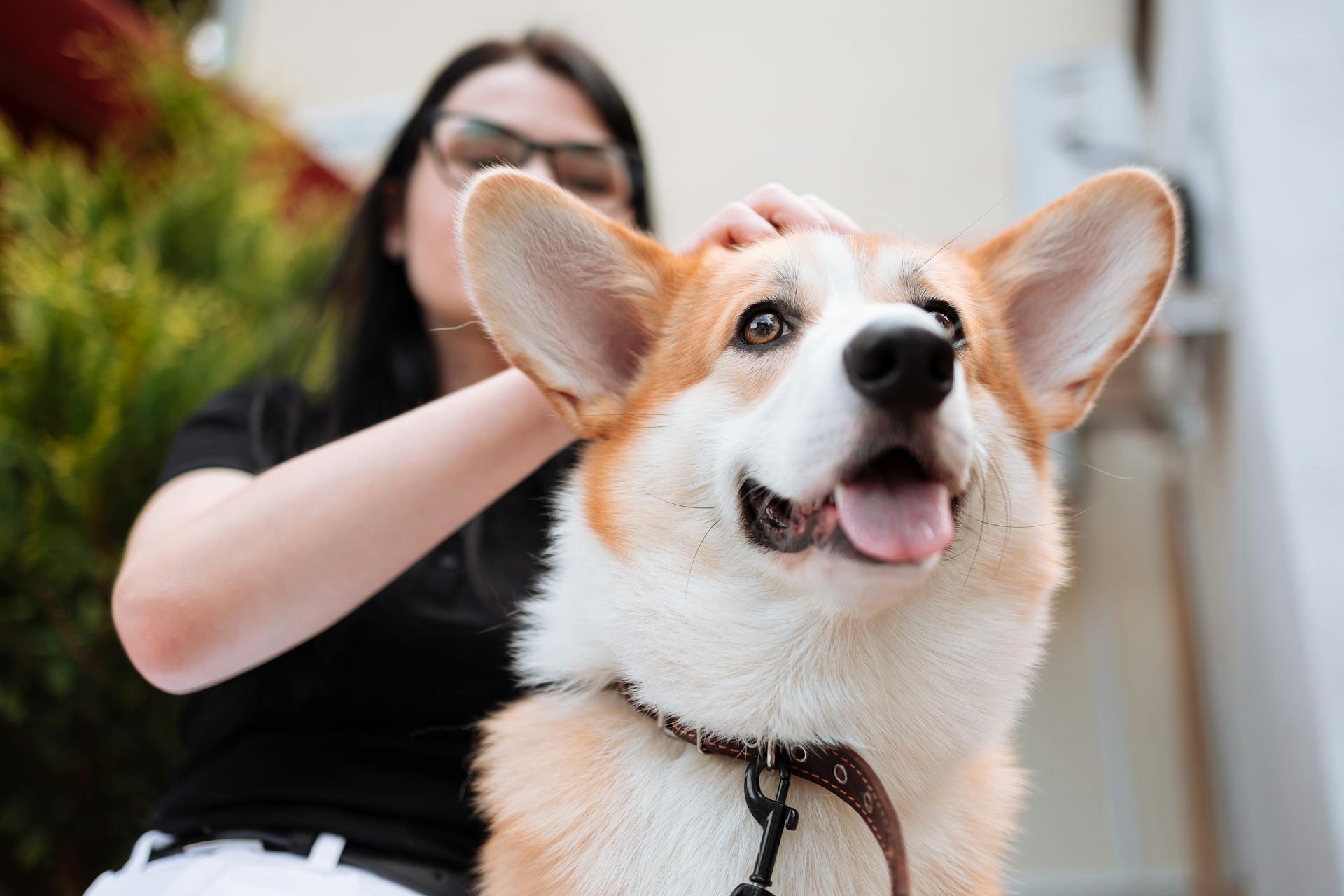
Shih Tzus are prone to back problems due to their long, narrow spine and short ribcage. This unique skeletal structure can put pressure on their spine, leading to issues like herniated discs and spinal stenosis.
Their weight and body type can also contribute to back problems, as excess weight puts additional strain on their spine. Shih Tzus can easily become overweight, which is a common issue among the breed.
Regular exercise and a healthy diet are essential for maintaining a healthy weight and reducing the risk of back problems. However, even with proper care, Shih Tzus can still develop back issues due to their genetic predisposition.
Consulting with a veterinarian is crucial in identifying the underlying cause of a Shih Tzu's back problems and developing an effective treatment plan.
Worth a look: Bolognese Dog Health Issues
What Is Shih Tzu Back Problems?
Shih Tzu back problems are a serious issue that affects many dogs in this breed. Intervertebral disc disease (IVDD) is a condition that causes the intervertebral discs to lose their sponginess and become hard and fragile.
IVDD can lead to a slipped disc, which presses on the spinal cord and causes pain, nerve problems, and sometimes paralysis. Certain breeds, including the Shih Tzu, are prone to IVDD due to the shape of their spine.
Shih Tzus are among the breeds that are more likely to develop back problems. If your Shih Tzu is experiencing symptoms of IVDD, it's essential to contact your vet right away.
The symptoms of IVDD can vary, but they often include pain, weakness, and loss of bladder or bowel control. If your Shih Tzu is in pain, phone your vet immediately.
Here are some breeds that are prone to IVDD:
- Dachshund
- French bulldog
- Shih Tzu
Causes and Symptoms
If your Shih Tzu is experiencing back problems, it's essential to know the signs and symptoms to get them the proper care.
Pain in the neck or back region is a common sign of IVDD in Shih Tzus.
Difficulty urinating and/or defecating can also be a symptom of IVDD, and it's crucial to seek veterinary attention if your dog is showing any of these signs.
Consider reading: Ivdd in Corgis
Shaking or trembling in response to pain is another sign of IVDD in Shih Tzus.
Knuckling on paws can be a sign of IVDD, and it's essential to have your dog checked by a veterinarian if you notice this behavior.
Back problems caused by IVDD can range from mild to severe, and it's essential to know the severity of the condition to get proper treatment.
A milder version of IVDD can cause mild back or neck pain in Shih Tzus.
Severe IVDD symptoms can cause loss of all sensation, lack of bladder and bowel control, and even paralysis in Shih Tzus.
Here are some common symptoms of IVDD in Shih Tzus:
- Pain in the neck or back region
- Unwillingness or inability to walk
- Difficulty urinating and/or defecating
- Shaking or trembling (usually in response to pain)
- Knuckling on paws
Diagnosis and Treatment
Diagnosis of Shih Tzu back problems, specifically Intervertebral Disc Disease (IVDD), often begins with a physical exam by your veterinarian to check your pet's orthopedic and neurologic condition. They may suspect IVDD based on your dog's symptoms and examination.
Further tests are usually necessary to confirm the diagnosis, which might include an MRI scan, as it's the best way to diagnose IVDD, showing the spine, nerves, bones, and discs in detail. X-rays can also be used, but they will only show some changes caused by IVDD and a slipped disc.
A different take: Ivdd in Dogs Breeds
Depending on the veterinarian's findings, your dog might need other investigations such as blood tests, a spinal tap, or a CT scan. If your veterinarian suspects IVDD, they will usually begin with a physical exam to check your pet's orthopedic and neurologic condition.
Conservative treatment for Shih Tzus with IVDD involves strict rest, pain relief, and physiotherapy. Your dog will need to stay in a crate or small space and only come out for short toilet trips, and it's essential to avoid jumping, running, or going up and down stairs while they're recovering.
Here are some essential parts of conservative treatment:
- Strict rest for several weeks is essential for most cases of IVDD.
- Pain relief is another essential part of conservative management.
- Slipped discs can sometimes cause problems with the nerves that control your dog's ability to pass urine.
If your dog is in severe pain or is unable to walk, they may need surgery. Surgery can be very successful, especially if it's carried out within a few days of symptoms developing. However, spinal surgery is a major operation, so it's essential to talk to your vet about the possible risks, recovery time, and costs before proceeding.
Diagnosis
Diagnosis of IVDD typically starts with a physical exam by your veterinarian to check your dog's orthopedic and neurologic condition.
Your vet might suspect IVDD, but further tests are usually necessary to confirm the diagnosis.
An MRI scan is the best way to diagnose IVDD because it shows the spine, nerves, bones, and discs in detail.
X-rays can show some but not all of the changes caused by IVDD, as they can't reveal nerves and the spinal cord.
Your vet might need to do other investigations such as blood tests, a spinal tap, or a CT scan depending on their findings.
The following breeds are predisposed to IVDD:
- Dachshund (45-70% of IVDD cases)
- Shih Tzu
- Beagle
- French bulldog
- Pekingese
Treatment Options
Treatment options for your dog's slipped disc depend on the severity of their symptoms. If they only have mild symptoms, treating them medically with pain relief, strict rest, and physiotherapy may be the best option.
Strict rest for several weeks is essential for most cases of IVDD. Your dog will need to stay in a crate or a small space and only come out for short toilet trips. They should not jump, run, or go up and down stairs while recovering.

Pain relief is another crucial part of conservative management. Your vet can prescribe pain relief in tablet or liquid form, but if that's not enough, your dog may need additional injections or hospitalization to control their pain.
If your dog is unable to pee, you'll need to empty their bladder for them while they recover. Your vet will show you how to do this safely.
If your dog is in severe pain or unable to walk, surgery may be necessary. Surgery can be very successful, especially if it's carried out within a few days of symptoms developing.
However, spinal surgery is a major operation, and it's essential to discuss the possible risks, recovery time, and costs with your vet before proceeding.
In some cases, treatment may not be possible, or your vet may think your dog is unlikely to recover. If your dog is in uncontrollable pain, unable to walk, or treatment is not possible, it may be the kindest option to consider euthanasia.
Surgery and Costs
IVDD surgery itself can cost anywhere from $1500 to $4000, and that does not include costs for x-rays and other imaging techniques that will be required to properly prepare for the surgery.
All-inclusive, the cost of surgical treatment for IVDD can land anywhere within a range of $3000-$8000 dollars.
It's a good idea to keep a savings fund or purchase pet care insurance in case the day comes where your Shih Tzu needs surgery.
Treatment costs for IVDD vary a lot depending on the treatment needed, and costs can mount up to several thousands of pounds if your dog has specialist treatment or spinal surgery.
Consider taking out dog insurance as soon as you bring your Shih Tzu home, before any signs of illness start, to give you peace of mind that you have some financial support if they ever become unwell.
Recovery and Prognosis
Most dogs with IVDD can make a full recovery if treated promptly, with a 90% success rate for grades 1-4 cases. The key is to catch the condition early and work with your veterinarian to determine the best course of action.
For dogs with grade 5 IVDD, the success rate drops to 50-60% if surgery is performed within 24 hours of symptom onset. However, even this number can drop further if surgery is delayed beyond 24 hours.
With proper treatment, many dogs can recover from IVDD without permanent damage, especially if the symptoms are caught early. In fact, for most dogs, the prognosis is very good, and they can make a full recovery.
Staying Balanced While Walking
Limiting your dog's activity to crate rest is crucial when they're arching their back and walking off balance. This helps prevent further injury and allows them to recover more quickly.
Every hour counts when it comes to Intervertebral Disc Disease, so seeking veterinary attention as soon as possible is essential.
Worth a look: Dogs Gums Bleeding When Chewing Toy
What Is the Prognosis?
The prognosis for dogs with IVDD is generally very good, with most dogs making a full recovery, especially if the condition is caught early.

For most dogs, the prognosis is excellent, with a 90% chance of making a full recovery if surgery is performed within 24 hours of grade 5 symptoms starting.
However, if surgery is delayed, the success rate drops to 50% or 60%, and even then, it's only if the surgery occurs within 24 hours of grade 5 symptoms beginning.
Catching IVDD early is crucial, as it can reduce the costs and risks of surgery, and may even prevent the need for surgery altogether.
Annual regular checkups with your vet can help catch IVDD early, which is essential for a good prognosis.
In fact, for dogs with mild IVDD, non-invasive treatments like pain medication and strict exercise confinement may be enough to help them recover.
But, if the condition continues to deteriorate, surgery may be necessary, and the sooner it's performed, the better the chances of a full recovery.
It's essential to follow your vet's instructions exactly and to contact them if you have any problems or are unsure about any of the steps.
With proper care and treatment, most dogs with IVDD can make a full recovery and return to their normal activities.
Breed and Risk
Shih Tzu back problems are a serious concern for many owners. IVDD, or Intervertebral Disk Disease, is a common issue that affects several breeds, including the Shih Tzu.
Dachshunds are particularly prone to IVDD, with an estimated 45-70% of cases affecting this breed.
Shih Tzus, Beagles, and French Bulldogs are also at risk, and owners should be aware of these potential health issues.
A physical exam by a veterinarian is usually the first step in diagnosing IVDD. They'll check the dog's orthopedic and neurologic condition to determine the severity of the condition.
Some breeds are more susceptible to IVDD due to their body shape and size. Here are some breeds that are at risk:
- Dachshund (45-70% of IVDD cases)
- Shih Tzu
- Beagle
- French bulldog
- Pekingese
Frequently Asked Questions
How can you tell if a Shih Tzu is in pain?
Look for signs such as limping, difficulty changing position, shaking, abnormal posture, excessive panting, changes in facial expression, and decreased appetite, which can indicate that your Shih Tzu is in pain. If you notice any of these symptoms, seek veterinary attention immediately to determine the cause and provide relief
Sources
- https://www.broadstreetvet.com/site/blog/2021/08/15/ivdd-in-dogs-surgery-cost-recovery
- https://sevneurology.com/blog/dog-arching-back-walking-off-balance
- https://www.pdsa.org.uk/pet-help-and-advice/pet-health-hub/conditions/ivddslipped-disc-in-dogs
- https://www.forbes.com/advisor/pet-insurance/pet-care/shih-tzu-common-health-issues/
- https://lilbackbracer.com/pages/all-about-ivdd
Featured Images: pexels.com


